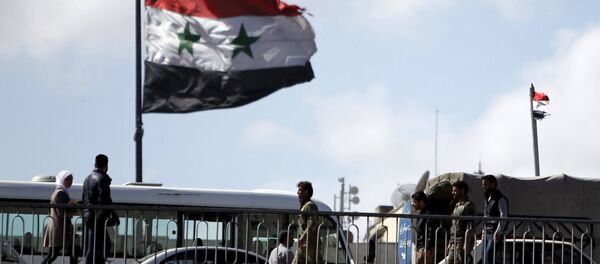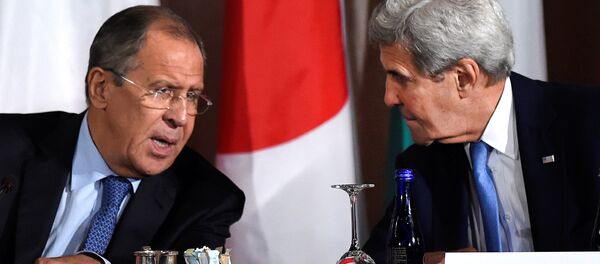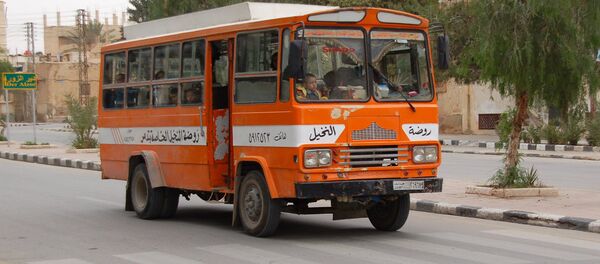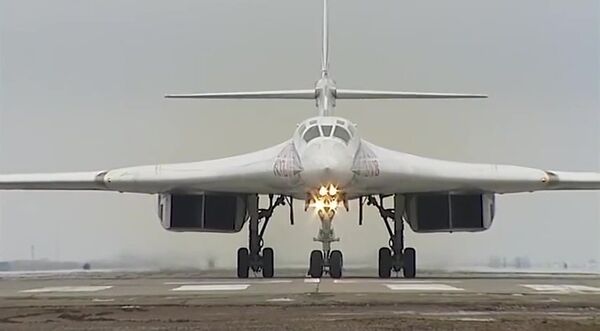MOSCOW (Sputnik) — An armed conflict has been raging in Syria since March 2011, with government forces battling paramilitary units of different terrorist and opposition organizations. Militants of the Daesh and the al-Nusra Front, a Syrian division of al-Qaeda that has changed its name to Jabhat Fatah al Sham, are the most active extremist groups in the country.
Since September 2014, the US-led coalition has been hitting Daesh positions in Syria without the permission of the Syrian authorities.
On September 30, 2015, Sergei Ivanov, then Chief of Staff of the Russian Presidential Executive Office, said Assad had requested military assistance from Russia. Russian President Vladimir Putin asked the Russian parliament to pass a resolution approving the deployment of the military contingent abroad. The proposal was unanimously supported. The operation was aimed at providing air support for the Syrian government forces fighting Daesh units.
That same day pilots of the national Aerospace Force launched high-precision air strikes against Daesh targets on the ground in Syria. An information center consisting of Russian, Iraqi, Iranian and Syrian representatives was established in Baghdad to coordinate the fight against terrorists. The center’s experts collect, process, sum up and analyze updates on the regional situation, allocate data and promptly submit it to the general staff of the countries involved.
On October 7, 2015, Russian Navy warships joined the Syrian operation for the first time. The Dagestan, Grad Sviyazhsk, Veliky Ustyug and Uglich warships launched 26 cruise missiles from the Caspian Sea and destroyed 11 targets.
On November 17, Tu-160 Blackjack, Tu-95MS Bear and Tu-22M3 strategic bombers joined the Russian Aerospace Forces' operation for the first time and launched a large-scale air strike against terrorist positions in Syria. On November 20, Russian Defense Minister Sergei Shoigu said the air wing had been expanded to include 69 fixed-wing aircraft and helicopters. At that time, 10 warships were involved in the operation, including six in the Mediterranean Sea.
After the loss of the Su-24 bomber, an S-400 Triumph surface-to-air missile (SAM) system was deployed at the Russian military base in Syria. Since then, all Russian strike planes are escorted by fighters. In turn, the Moskva guided missile cruiser boasting the Fort air defense system, similar to the S-300 SAM, was deployed near Latakia for more effective air defense. On December 8, Russia’s submerged Rostov-on-Don diesel-electric submarine launched Kalibr long-range cruise missiles for the first time and hit all designated targets.
Initially, Russian warplanes hit terrorist command centers, headquarters, communications centers, weapons, ammunition and petroleum, oil and lubricants depots, small factories for manufacturing improvised explosive devices and car bombs. However, later, they started hitting mostly Daesh-controlled oilfields, pipelines and refineries in an effort to undermine the sources of terrorists’ revenues. Russian warplanes also hunted down and destroyed oil trucks.
Hounded by Russian aviation, the militants began to fall back and lost most of their weapons and equipment along the demarcation line separating them from Syrian forces.
The Russian Aerospace Forces' Syrian operation forced the opposition to launch peace talks with Syrian authorities for achieving a political settlement of the crisis. The talks began on January 29, 2016 in Geneva under UN Security Council Resolution 2254.
On February 22, Russia and the United States said they had reached agreement on the Syrian ceasefire regime.
The Syrian ceasefire regime officially entered into force at midnight February 27. It did not apply to the Daesh and Jabhat Fatah al Sham, which are banned in Russia and some other countries, as well as to other paramilitary units listed among terrorist organizations by the UN Security Council.
Russian warplanes scaled down their operations after the opposition and government forces reached a ceasefire agreement. The number of combat missions decreased three-fold, from 68 daily to 20-30. The previously established air wing therefore proved excessive.
On March 14, 2016, Putin ordered Shoigu to start withdrawing the air wing from Syria starting March 15 because it had accomplished its objectives. The decision was coordinated with Assad who supported it.
The first two Russian aviation units left Hmeimim air base on March 15.
On March 28, Valery Gerasimov, Chief of the General Staff of the Russian Armed Forces, said all tactical planes, scheduled for withdrawal, had already been redeployed to Russia, and that army aviation and some logistics support units were still being withdrawn.
While redeploying its air wing from Syria, the Russian Federation did not renounce its obligations to deliver weapons and military equipment to the people of Syria. Hmeimim air base and the Russian Navy’s logistics support facility in Tartus also continued to operate.
On March 27, the Syrian army and militia, supported by the Russian Aerospace Forces, completely established control over the city of Palmyra the ancient ruins of which are listed among UNESCO’s World Heritage Sites. The city was controlled by the Daesh militants since mid-May 2015. Later, Russian combat engineers defused about 19,000 explosive devices in Palmyra.
Over the last few months, the Russian Aerospace Forces actively supported Syrian government forces, helping them repel enemy attacks and launching selective strikes against militants. The most intense fighting raged in Aleppo governorate. In late July, Russia and Syria launched a large-scale humanitarian operation in the city and established several humanitarian corridors for the evacuation of the civilians from militant-controlled districts. Russian service personnel even para-dropped food, medications and essentials to the people of Aleppo besieged by the militants.
On August 9, Russia and Syria signed an agreement on permanent deployment of the Russian air wing in Latakia governorate.
On August 16, the Russian Aerospace Forces used Hamadan airfield in Iran for the first time to bomb the facilities of the Daesh and Jabhat Fatah al Sham. After successfully accomplishing their combat mission, all warplanes of the Russian Aerospace Forces returned to their bases.
The Russian air wing in Syria made it possible to completely turn the tide of the war, its planes and helicopters flew over 15,000 combat missions and seriously damaged facilities of the terrorist infrastructure. They destroyed thousands of strongpoints, underground depots with ammunition, weapons, military equipment, other assets and materials, petroleum, oil and lubricants and explosives, as well as over 200 oilfields, pipelines and refineries and over 2,000 oil trucks that delivered petroleum to Turkish refineries. The Aerospace Forces helped kill about 28,000 militants in Syria. Over 2,000 terrorists with Russian passports, including 17 field commanders, were killed during the Russian military operation.
On March 17, 2016, the Russian president said four Russian service personnel had been killed during the Syrian operation. The deaths of nine Russian service personnel were reported from March through July 2016. On August 1, five more Russians were killed in an attack on a Russian Mi-8 Hip military-transport helicopter.
A package of Russian-US agreements regarding the Syrian ceasefire regime entered into force on September 12, 2016. First of all, the package aims to achieve a ceasefire and to coordinate operations between Russian and US personnel. A seven-day ceasefire regime was introduced but it was not extended on September 19.
The Russian side noted that only Damascus honored the ceasefire agreement, with the opposition and various terrorist organizations using the ceasefire regime to regroup their forces. Moscow also stresses that the United States has so far failed to fulfill its obligations and to discern between the opposition and terrorists.







